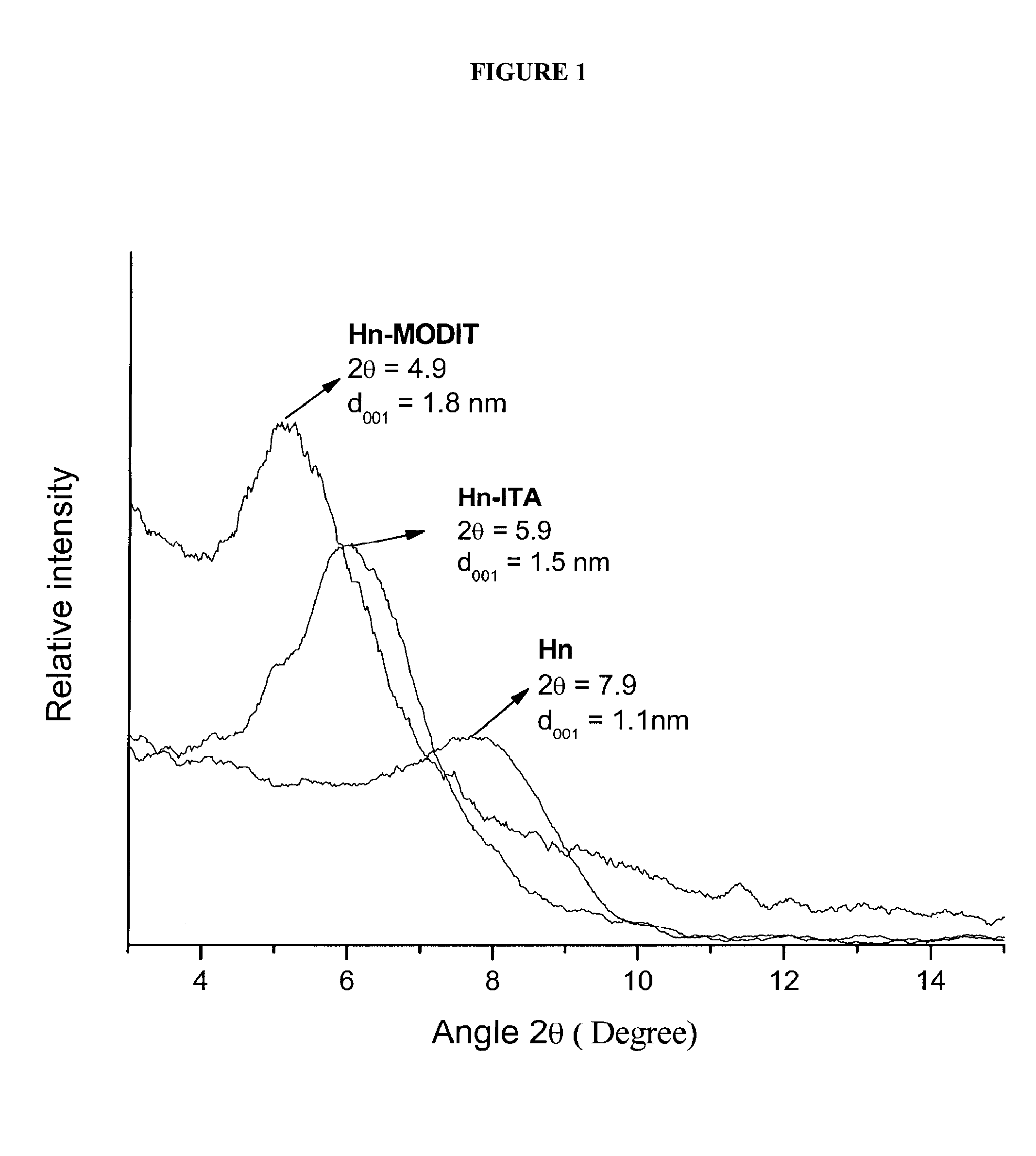Hybrid clays for obtaining nanocomposites and a preparation process therefore
a technology of hybrid clay and nanocomposites, which is applied in the directions of organic chemistry, transportation and packaging, and silica compounds, can solve the problems of difficult dispersibility in a polymer matrix, inability to meet the requirements of certain plastic materials, and inability to separate modified clay from the aqueous phase, so as to facilitate the dispersion of hybrid clay in polymers and improve mechanical and thermal properties.
- Summary
- Abstract
- Description
- Claims
- Application Information
AI Technical Summary
Benefits of technology
Problems solved by technology
Method used
Image
Examples
example 1
[0069]Methodology for obtaining hybrid clays or clays intercalated with the monomers ITA or MODIT, of used in this invention.
[0070]The clays used are of the smectic type, such as montmorillonite (Mo) and natural hectorite (Hn), supplied by the Netherland Organisation for Applied Scientific Research-NTO of Holland (Table 1).
TABLE 1Cation exchange capacity (CEC), interlaminar distance(d001) plane, elemental composition and empiricalformula of the clays used in this invention.MontmorilloniteNatural HectoriteCodeMoHnCEC83100(meq / 100 g)d001 (nm)1.211.13SiO2 (%)54.451.0Al2O3 (%)18.21.7Na2O (%)3.52.9Li2O (%)0.9Fe2O3 (%)3.50.6MgO (%)2.021.3CaO (%)0.61.8K2O (%)0.20.4EmpiricalM0.62(Al1.58, Mg0.22)M0.78(Al0.16Mg2.49, Li0.28)formulaSi4O10(OH)2•nH2OSi4O10(OH)2•nH2O
[0071]In this example the stages for obtaining hybrid montmorillonite (Mo) by intercalation of ITA in an acid medium are described; they comprise the cation exchange reaction with the ITA monomer. For that purpose a suspension of Mo in...
example 2
[0076]Methodology for obtaining nanocomposites based on polyolefins and hybrid clays of this invention.
[0077]The polyolefin / hybrid clay nanocomposite of this invention comprises the following raw materials: i) polyolefin; ii) hybrid clay corresponding to clay intercalated with either ITA or MODIT monomers; iii) compatibilizer such as PP-g-ITA or PP-g-MODIT; and iv) antioxidants.
[0078]i) The commercial polyolefins used were Ziegler-Natta polypropylene (PP) homopolymers from Petroquim S. A. designated as PP ZN340, PP ZN 250 and PP ZN150 respectively with melt flow indexes (MFI) of 3, 13 and 26. The properties of PP samples used are shown in Table 3.
TABLE 3Melt flow index (MFI), average molecular weights ( Mw and Mn), polydispersity index (Pd), tensile modulus(E), tensile strength (σy), deformation at break (ε)of the Ziegler Natta (ZN) PP samples.MwEεPPMFI(Kg. / mol)Pd ( Mw / Mn)(MPa)σy (MPa)(%)ZN 34033403.91090 ± 3030 ± 1250ZN 250132503.41080 ± 4030 ± 2100ZN 150261504.41092 ± 4532 ± 220
[...
PUM
| Property | Measurement | Unit |
|---|---|---|
| temperature | aaaaa | aaaaa |
| temperature | aaaaa | aaaaa |
| temperature | aaaaa | aaaaa |
Abstract
Description
Claims
Application Information
 Login to View More
Login to View More - R&D
- Intellectual Property
- Life Sciences
- Materials
- Tech Scout
- Unparalleled Data Quality
- Higher Quality Content
- 60% Fewer Hallucinations
Browse by: Latest US Patents, China's latest patents, Technical Efficacy Thesaurus, Application Domain, Technology Topic, Popular Technical Reports.
© 2025 PatSnap. All rights reserved.Legal|Privacy policy|Modern Slavery Act Transparency Statement|Sitemap|About US| Contact US: help@patsnap.com

